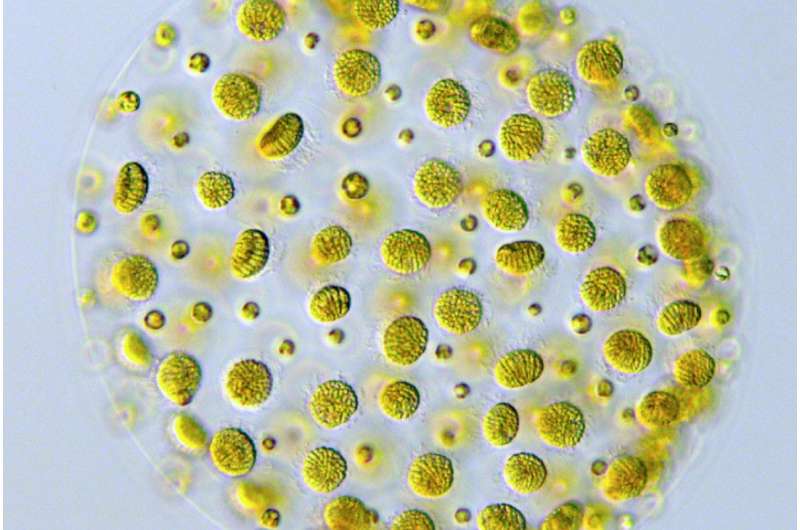This article has been reviewed according to Science X's editorial process and policies. Editors have highlighted the following attributes while ensuring the content's credibility:
fact-checked
peer-reviewed publication
trusted source
proofread
Discovery of new gene unveils sex determination in green algae

An international team of researchers led by Dr. James Umen at the Donald Danforth Plant Science Center has made a groundbreaking discovery in the world of developmental biology. In their latest study on volvocine green algae, the scientists identified a new gene, named VSR1, that plays a vital role in the activation of genes specific to the development of female and male reproductive cells.
In doing so, the researchers unveiled a comprehensive model for how sex is determined in green algae, opening the door for improving traits in similar species through targeted breeding and selection—with important implications for biotech, biofuels, and agriculture. This work, titled, "A conserved RWP-RK transcription factor VSR1 controls gametic differentiation in volvocine algae," was recently published in the journal Proceedings of the National Academy of Sciences.
Volvocines are a group of green algae that include two well-studied members: Chlamydomonas, a single-celled species, and Volvox a multicellular species. All volvocines, and most other green algae, can reproduce asexually; but under specific conditions they undergo sexual development and differentiate as either plus and minus gametes for Chlamydomonas, or eggs and sperm for Volvox.
Until this study only part of the sexual differentiation process was understood. Much like the Y chromosome gene SRY acts as a male determinant in humans and other mammals, a sex-linked gene called MID in volvocine algae causes sperm development in Volvox or minus gamete differentiation in Chlamydomonas. What has remained mysterious until now was how the default pattern of plus or female gamete differentiation occurs when MID is absent.
Using phylo-transcriptomics—a method to simultaneously compare evolutionary relationships and gene expression—the team discovered a new gene called Volvocine Sex Regulator 1 (VSR1) that activates the development of plus gametes in Chlamydomonas or oogenesis (egg formation) in Volvox. However, Dr. Umen noted, "this gene is not just for females. When MID is present, it interacts with VSR1 and modifies its activity, switching it from a plus or female gene activator to a minus or male gene activator."
By discovering the role of VSR1 and its interaction with MID, the researchers for the first time could develop a complete model for sex determination in these algae.
This work was the result of five years of cross-institutional collaboration between Dr. Umen's lab and their colleagues in Japan at Kyoto University and Chuo University. Co-first author Dr. Takashi Hamaji, current Postdoctoral Associate at the Danforth Center and former Postdoctoral Associate at Kyoto University, had "long been convinced that a gene was interacting with MID but didn't know which gene to suspect." The international collaboration between research groups with complementary expertise was crucial to discovering VSR1 and unravel its relationship with MID.
In addition to the breakthrough for understanding sex determination in volvocine algae, the new findings may extend to other groups of green algae where lack of information about sexual cycles has precluded selective breeding as a mechanism of strain improvement. Remarkably, in every other green algal group where there is some piece of information about sexual differentiation, genes in the same family as VSR1 and MID are implicated, and this even holds true in plants which share a common ancestor with the green algae.
"Our results help tie together an emerging story where VSR1- and MID-like genes may have been involved in sexual differentiation at the very base of the lineage that gave rise to plants and algae, and searching for similar gene pairs in other species may help unveil their sex determination mechanisms as well," says Dr. Umen.
Looking ahead, the research team plans to further investigate the interactions between VSR1 and MID, and how the presence of MID changes VSR1 from an activator of plus or female genes to an activator of minus of male genes. "This paper presents a very fruitful finding, and I can't wait to continue studying this system," Dr. Hamaji says.
More information: Sa Geng et al, A conserved RWP-RK transcription factor VSR1 controls gametic differentiation in volvocine algae, Proceedings of the National Academy of Sciences (2023). DOI: 10.1073/pnas.2305099120
Journal information: Proceedings of the National Academy of Sciences
Provided by Donald Danforth Plant Science Center


















